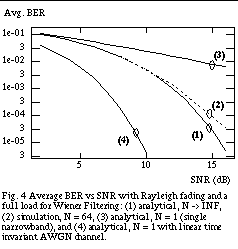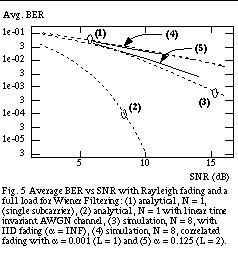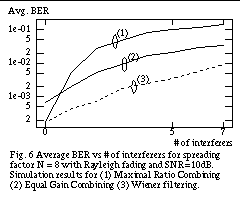With orthogonal MC-CDMA, each data symbol is simultaneously
transmitted at N binary phase shift-keying (BPSK) narrowband subcarriers,
each separated by F/Tb Hz where F is an integer.Due to its special signal
structure, MC-CDMA signals will not experience significant linear distortion
in fading channels where the symbol duration,  , is much larger than the delay spread,
, is much larger than the delay spread,  . As shown in the transmitter model of Fig. 1, each of the N subcarrier
waveforms is modulated (multiplied) by a single (time constant) chip belonging
to a spreading code of length N. Different users transmit at the same set
of subcarriers but with a different spreading code in the frequency domain.
In contrast to Direct-Sequence CDMA.
(or other wideband) signals, MC-CDMA signals are not significantly affected
by delay spreads due to their narrowband composition. This modulation technique
should not be confused with transmitting multiple DS-CDMA signals at different
frequencies. Note that the signal structure of MC-CDMA is similar to that
of Orthogonal Frequency Division Multiplexing (OFDM). but the manner in which the signals are
used is very different.
. As shown in the transmitter model of Fig. 1, each of the N subcarrier
waveforms is modulated (multiplied) by a single (time constant) chip belonging
to a spreading code of length N. Different users transmit at the same set
of subcarriers but with a different spreading code in the frequency domain.
In contrast to Direct-Sequence CDMA.
(or other wideband) signals, MC-CDMA signals are not significantly affected
by delay spreads due to their narrowband composition. This modulation technique
should not be confused with transmitting multiple DS-CDMA signals at different
frequencies. Note that the signal structure of MC-CDMA is similar to that
of Orthogonal Frequency Division Multiplexing (OFDM). but the manner in which the signals are
used is very different.
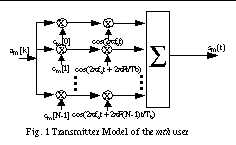
While the general shape of each individual subcarrier will
not experience significant linear distortion after transmission, the flat fading that each
subcarrier with experience results in an amplitude scaling. Unequal scaling a different
subcarriers distorts the orthogonality between users. While the conventional detection
methods of equal gain combining (EGC) and maximal ratio combining (MRC) may be sufficient
in an additive white Gaussian noise (AWGN) channel, these detection methods do not
directly address the issues of orthogonality and of interference cancellation.
Consequently, these detection methods do not perform as well in interference limited
channels.
In this paper, we will apply Wiener filtering to the
detection of MC-CDMA signals. Wiener filtering is optimal in a mean-squared error sense
with respect to both the noise and the interference. In most fading channels, the
determination of the Wiener coefficients is performed adaptively. In this paper, we are
primarily concerned with the theoretical limits and not the implementation aspects of how
to track the channel fluctuations. Thus, it is
assumed that accurate estimates of the complete channel state information (i.e., the
fading at the subcarriers) are available and that the Wiener coefficients are chosen
accordingly.
Channel Model
Denote the vector of the data symbols by

where the mth column vector of C corresponds to the spreading
code,  , of the mth user.
Using the vector and matrix notation described above, an equivalent discrete vector
representation of the transmitted signal described in Fig. 1 is
, of the mth user.
Using the vector and matrix notation described above, an equivalent discrete vector
representation of the transmitted signal described in Fig. 1 is

where si[k] represents the signal components of all users at
the ith subcarrier for the kth symbol interval. The actual continuous-time transmitted
signal corresponding the kth data symbol of the mth user, am[k], is

where . denotes the inner product between
two vectors and

is a vector containing the spreading code of the mth user.
In this paper, we will focus on downlink transmissions, i.e.,
from the base station to the mobiles. Assuming that the delay spread is much smaller than
the symbol duration, the effect of the channel at the ith subcarrier may be approximated
by a constant amplitude scaling, pi[k], and a constant phase offset,  , over the symbol duration.
Using this assumption, the index k will be suppressed throughout the rest of this paper.
Applying the received signal to the receiver model shown in Fig. 2, the equivalent
discrete representation of the received signal is
, over the symbol duration.
Using this assumption, the index k will be suppressed throughout the rest of this paper.
Applying the received signal to the receiver model shown in Fig. 2, the equivalent
discrete representation of the received signal is

where  represents the component of the received signal at the ith subcarrier, the
channel matrix H is defined to be
represents the component of the received signal at the ith subcarrier, the
channel matrix H is defined to be
 ,
,
and  is a vector containing the corresponding AWGN terms with
is a vector containing the corresponding AWGN terms with  representing
the noise term at the ith subcarrier with power
representing
the noise term at the ith subcarrier with power  . Obviously, the discrete representation of the demodulated signal
is an approximation. However, under the condition
. Obviously, the discrete representation of the demodulated signal
is an approximation. However, under the condition  , each subcarrier faces a relatively flat channel.
, each subcarrier faces a relatively flat channel.
Linear Receivers
The application of Wiener filtering to this received signal
involves linearly combining the different subcarrier diversity components to yield the
decision variable

where the vector  represents the optimal weighting coefficients. These coefficients
can also be viewed as an amplitude equalization to compensate for the fading at the
subcarriers. Arbitrarily choosing m = 0 as the desired signal, the optimal choice of the
equalization vector D in the mean-squared sense can be determined to be
represents the optimal weighting coefficients. These coefficients
can also be viewed as an amplitude equalization to compensate for the fading at the
subcarriers. Arbitrarily choosing m = 0 as the desired signal, the optimal choice of the
equalization vector D in the mean-squared sense can be determined to be

where

represents the autocorrelation matrix of the received vector
Y and  represents the
cross-correlation vector between the desired symbol, a0, and the received signal vector,
Y. In the formulation of this method, it is assumed that estimates of the channel
amplitudes,
represents the
cross-correlation vector between the desired symbol, a0, and the received signal vector,
Y. In the formulation of this method, it is assumed that estimates of the channel
amplitudes,  , are
available and are consequently treated as deterministic constants.
, are
available and are consequently treated as deterministic constants.
A closed form solution is difficult to obtain except for the
case of a full load, i.e., when all N users are active. The corresponding equalization
coefficient at the ith subcarrier for a full load is

where
 and
and
 .
.
In obtaining this expression, independent and identically distributed (IID) fading at
the subcarriers was assumed.
To study the effect of correlated fading through
simulations, the following algorithm for generating correlated Rayleigh
r.v.s was used. The correlation between two frequencies separated by  radians in a complex gaussian fading channel is given in Jakes Jr., Microwave Mobile Communications,
New York: Wiley, 1974. to be
radians in a complex gaussian fading channel is given in Jakes Jr., Microwave Mobile Communications,
New York: Wiley, 1974. to be
 .
.
where  and
and  is the local-mean power of the mth user. Defining
is the local-mean power of the mth user. Defining  as a vector of dimension N whose elements, hi for i =
0, 1, ..., N-1, are the complex correlated gaussian fading variables at
the different subcarriers, the autocorrelation matrix of
as a vector of dimension N whose elements, hi for i =
0, 1, ..., N-1, are the complex correlated gaussian fading variables at
the different subcarriers, the autocorrelation matrix of  ,
,  where
where  denotes the
conjugate transpose of
denotes the
conjugate transpose of  , can be determined. The vector
, can be determined. The vector  can be generated
by taking linear combinations of independent, idenctically distributed (i.i.d.)
unit normal gaussian random variables, using
can be generated
by taking linear combinations of independent, idenctically distributed (i.i.d.)
unit normal gaussian random variables, using

where G is a vector of dimension N containing i.i.d. unit
normal r.v.s. A possible choice of the  transformation matrix A is
transformation matrix A is
 .
.
Simulation and Numerical Results
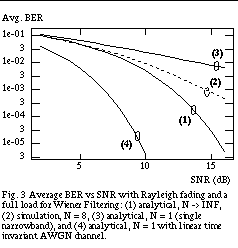
Due to the lengthy time consumption of the simulations,
results for only spreading factors of N = 8 and N = 64 were obtained. Shown in Fig. 3 is a
plot of the average BER versus the signal-to-noise ratio (SNR) in a Rayleigh fading
channel for a full load with N = 8. IID fading at the subcarriers is assumed. It is also
assumed that all users are received with equal power. Note that the analytical results for
Wiener filtering differ significantly from the simulation results for large SNR. This
discrepancy is due to the application of the Central Limit Theorem to small spreading
factors. Shown in Fig. 4 are the results for N = 64. Examining Fig. 3 and 4, it can be
seen that See is more accurate for large N. Also
included in Fig. 3 are the curves for a single narrowband subcarrier with AWGN, and with
and without fading. Note that the performance of MC-CDMA is better than a single
narrowband transmission due to frequency diversity even with a fully loaded system.
The average BER versus the SNR for correlated fading was also
examined for the case of N = 8 (see Fig. 5). The degree of correlation was measured in
terms of
 .
.
Small a's correspond to highly correlated fading at the
subcarriers while large a's correspond to IID fading. Ideally, the larger the value of a,
the higher the degree of frequency diversity. In a DS-CDMA system, the number of
resolvable paths is equal to
 .
.
Note that for a = 0.125 (L = 2) most of the benefits in
performance from frequency diversity have already been achieved.
Shown in Fig. 6 is a plot of the simulation results for the
average BER versus the number of interferes. The SNR was chosen to be 10dB. Because of the
time consuming nature of the simulator, a relatively small spreading factor of N = 8 was
used. Besides the curves for Wiener filtering, the simulation results of conventional EGC
and MRC detection are also included See N. Yee, J. P.
Linnartz and G. Fettweis, "Multi-Carrier CDMA in Indoor Wireless Radio
Networks," Proceedings PIMRC '93, Yokohama, Japan, 1993, pp. 109-113. . As
expected, Wiener filtering outperforms EGC and MRC substantially in combating
interference.
![]() , is much larger than the delay spread,
, is much larger than the delay spread, ![]() . As shown in the transmitter model of Fig. 1, each of the N subcarrier
waveforms is modulated (multiplied) by a single (time constant) chip belonging
to a spreading code of length N. Different users transmit at the same set
of subcarriers but with a different spreading code in the frequency domain.
In contrast to Direct-Sequence CDMA.
(or other wideband) signals, MC-CDMA signals are not significantly affected
by delay spreads due to their narrowband composition. This modulation technique
should not be confused with transmitting multiple DS-CDMA signals at different
frequencies. Note that the signal structure of MC-CDMA is similar to that
of Orthogonal Frequency Division Multiplexing (OFDM). but the manner in which the signals are
used is very different.
. As shown in the transmitter model of Fig. 1, each of the N subcarrier
waveforms is modulated (multiplied) by a single (time constant) chip belonging
to a spreading code of length N. Different users transmit at the same set
of subcarriers but with a different spreading code in the frequency domain.
In contrast to Direct-Sequence CDMA.
(or other wideband) signals, MC-CDMA signals are not significantly affected
by delay spreads due to their narrowband composition. This modulation technique
should not be confused with transmitting multiple DS-CDMA signals at different
frequencies. Note that the signal structure of MC-CDMA is similar to that
of Orthogonal Frequency Division Multiplexing (OFDM). but the manner in which the signals are
used is very different.


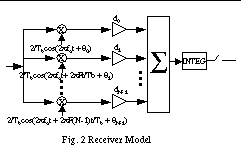
 ,
,
 .
.
